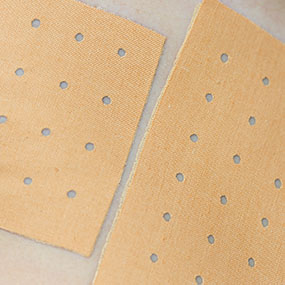Help on the Shelves
Although the Urology Care Foundation estimates that 33 million people in the U.S. live with overactive bladder (OAB), the real numbers may be much higher. Many people may be too embarrassed to talk about symptoms like the sudden and urgent need to urinate, urinary frequency, and accidents.
You don’t need to live with OAB, or keep it a secret. Help may be available at the nearest pharmacy, but first find out what you need to know before you choose a remedy.

The drug oxybutynin may be used to treat OAB. It is available over-the-counter in patch form, which delivers 3.9 mg of oxybutynin daily through your skin. However, the over-the-counter patch is only available to women. Men may take oxybutynin in patch or oral form, but they need a prescription for it.
It’s important that women talk to their doctor about symptoms before attaching the over-the-counter patch. Your doctor may test your urine to be sure there is no sign of infection, and may want to rule out a kidney condition or other disorders.
Place the oxybutynin patch on dry, unbroken skin on your abdomen, hip, or buttock. Remember not to use oil, lotion, or perfume in that area. Stay away from your waist, where clothes might rub off the patch.
Leave the patch on for four days. Change the patch after four days, and choose another spot to avoid skin irritation. For consistency, apply the patch on the same two days of the week. Note the days on your calendar, or on the medication package.
Oxybutynin is an anticholinergic drug. This means that the drug blocks the chemical acetylcholine, which controls smooth muscle contraction. In the bladder, oxybutynin acts on acetylcholine receptor cells in the detrusor muscle, the large bladder muscle that squeezes out urine. Reducing the number of detrusor spasms allows the bladder to fill with urine before triggering the sensation of having to go.
Although side effects may be less intense with the patch than with oral oxybutynin, you may experience dry mouth and eyes. Using artificial tears and eating a sugarless hard candy can help relieve dryness. Because the drug can also be constipating, which can worsen OAB symptoms, it’s important to eat plenty of high-fiber fruits and vegetables.
The patch can make you sleepy, so be aware that alcohol heightens this effect. Until you have used the patch long enough to gauge its effects on you, don’t drive or operate machinery. This may be a significant limitation if you drive to work or have a job that involves operating machinery.
An abundance of herbal products claim to give you “confidence,” make your bladder “better,” or help you “go less.” However, the science behind these assertions is very thin. Some animal studies show a potential effect of certain herbs on the bladder, but the studies are small and haven’t been repeated on a large scale in humans, if at all.

There isn’t enough data to support the use of green tea extract to minimize OAB symptoms. One animal
But no studies in humans measure the effect of green tea catechins on the bladder. And, the green tea extract label may not tell you how much caffeine is in the product. Caffeine is a bladder irritant that can worsen OAB symptoms.

The Japanese supplement gosha-jinki-gan combines 10 herbs. A small
The Chinese herbal blend hachi-mi-jio-gan—HE for short—contains several of the same herbs found in gosha-jinki-gan. HE may inhibit bladder contractions prompted by the chemical acetylcholine, according to a Japanese study done on rats. No human trials have been conducted.

Cleavers, or “sticky willy,” is a plant that clings to everything, as its name implies. Cleavers tea is marketed as “detoxifying” and as providing “lymphatic support,” but no evidence documents its use to reduce OAB symptoms.
Corn silk, the strands you pluck from corn before eating it, is also used to make a tea. This tea is said to ease urinary tract infection symptoms, but no data backs up that claim. Nor is there scientific proof that corn silk would help OAB.

A flowering plant native to the mountainous areas of South Africa, buchu has a long history of traditional use. Legend has it that buchu helps heal everything from fevers to coughs to urinary tract infections.
Buchu tea has no caffeine, so swapping your morning coffee or black tea for buchu will cut your caffeine consumption. That may be helpful in easing OAB symptoms, but don’t expect a cure-all. No studies measure buchu’s effect on OAB.

Horsetail (equisetum), an ancient plant that resembles a bristly tail when dried, may produce a mild diuretic effect. The goal of OAB treatment is control over random bladder spasms, not increased urine flow. The diuretic effect and lack of studies mean you should cross horsetail off your list if you’re looking for help for OAB.
The same is true for cranberries. The fruit is very acidic, which may aggravate the symptoms of OAB. Cranberries may change the way bacteria adheres to the bladder in a urinary tract infection, but bacteria isn’t involved in involuntary contractions that cause OAB.
Resiniferatoxin (RTX) comes from the resin of a cactus-like plant that grows in Morocco. This toxin affects neurons that send pain messages to the brain. Theoretically, the analgesic effect could work on the bladder, but no research in people with OAB confirms this idea.
An animal
